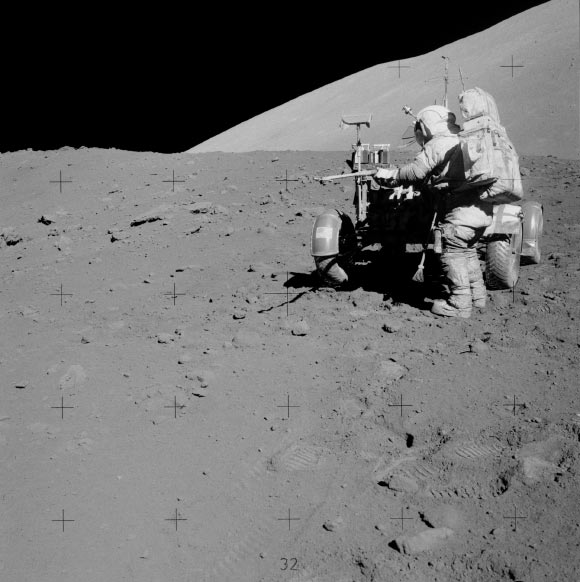The leading hypotheses for the origin of the Moon call for a giant impact event between proto-Earth and a separate impactor called Theia. The efficiency of mixing material among these two planetary bodies remains a subject of debate. Inefficient mixing during this process could leave behind remnants of the composition of the proto-Earth and/or Theia. The sulfur isotope composition of primordial components that survived this impact event could be used to place constraints on the chemistry of the early Solar Nebula and the distribution of sulfur components throughout the early Solar System, as well as the efficiency of mixing during the giant Moon-forming impact event. In a new paper, scientists from Brown University and elsewhere present anomalous sulfur isotope data from lunar rocks taken from the Moon’s Taurus Littrow region during Apollo 17. Their analysis shows that volcanic material in the samples contains sulfur compounds that are highly depleted of sulfur-33, one of four radioactively stable sulfur isotopes; these depleted samples contrast sharply with sulfur isotope ratios found on Earth and indicate the presence of either: (i) exotic chemistry and crustal recycling during the early evolution of the Moon or (ii) material that was not well mixed during the Moon-forming event.

Commander Eugene Cernan retrieves a drive tube from the Lunar Roving Vehicle during an Apollo 17 EVA. Image credit: NASA.
Certain elements carry distinctive ‘fingerprints’ in the form of isotope ratios — subtle variations in the weight of their atoms.
If two rocks share the same isotopic fingerprint, it’s a strong clue they came from the same source.
In the case of the Moon and Earth, researchers have shown broad similarities in the two bodies’ oxygen isotopes.
“It has long been assumed that sulfur isotopes would tell a similar story,” said Dr. James Dottin, a researcher at Brown University.
“Before this, it was thought that the lunar mantle had the same sulfur isotope composition as Earth.”
“That’s what I expected to see when analyzing these samples, but instead we saw values that are very different from anything we find on Earth.”
The samples the authors analyzed were taken from a double drive tube — a hollow metal cylinder driven some 60 cm into the lunar soil by Apollo 17 astronauts Gene Cernan and Harrison Schmitt.
Once returned to Earth, NASA sealed the tube in a helium chamber to keep the sample in pristine condition for future research under a program called Apollo Next Generation Sample Analysis (ANGSA).
In the last few years, NASA has begun making the ANGSA samples available to academic researchers through a competitive application process.
Dr. Dottin and colleagues proposed to analyze sulfur isotopes using secondary ion mass spectrometry, a highly precise method of isotope analysis that didn’t exist in 1972 when the samples were first returned to Earth.
For his work, they sought specific samples from the drive tube that appeared to be mantle-derived volcanic rock.
“There are two potential explanations for the anomalous sulfur,” Dr. Dottin said.
They could be a remnant of chemical processes that took place on the Moon early in its history.
Depleted sulfur-33 ratios are found when sulfur interacts with ultraviolet light in an optically thin atmosphere.
The Moon is thought to have had a short-lived atmosphere early in its history, which could have supported that kind of photochemistry.
If that is indeed how the samples were formed, it has some interesting implications for the evolution of the Moon.
“That would be evidence of ancient exchange of materials from the lunar surface to the mantle,” Dr. Dottin said.
“On Earth, we have plate tectonics that does that, but the Moon doesn’t have plate tectonics.”
“So this idea of some kind of exchange mechanism on the early Moon is exciting.”
The other possibility is that anomalous sulfur is left over from the formation of the Moon itself.
The leading explanation for the Moon’s formation is that a Mars-sized object, called Theia, collided with Earth early in its history.
Debris from that collision eventually coalesced to form the Moon.
It’s possible that Theia’s sulfur signature was far different from that of Earth, and that those differences have been recorded in the lunar mantle.
It’s not clear from this research which of those possible explanations is the right one.
“More study of sulfur isotopes from Mars and other bodies may one day help scientists find the answer,” Dr. Dottin said.
“Ultimately, understanding the distribution of isotope signatures will help scientists better understand how the Solar System formed.”
The study was published in the Journal of Geophysical Research: Planets.
_____
J.W. Dottin III et al. 2025. Endogenous, yet Exotic, Sulfur in the Lunar Mantle. JGR: Planets 130 (9): e2024JE008834; doi: 10.1029/2024JE008834







